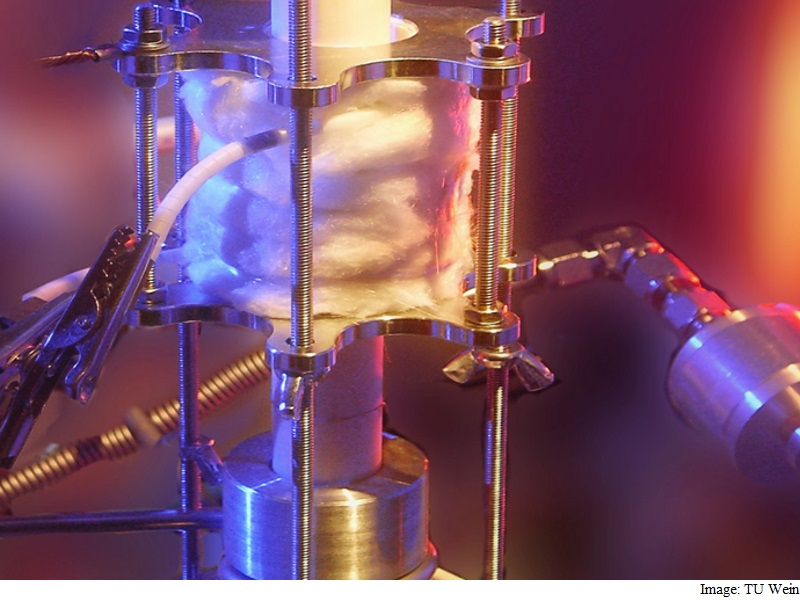- Home
- Science
- Science News
- Scientists Develop Cell That Can Chemically Store Solar Power
Scientists Develop Cell That Can Chemically Store Solar Power

Plants can absorb sunlight and store its energy chemically. However, imitating this on large industrial scale is difficult. Photovoltaics convert sunlight to electricity but at high temperatures, the efficiency of solar cells decreases.
The researchers from the Vienna University of Technology (TU Wien) were able to solve this problem by combining high temperature photovoltaics with an electrochemical cell.
This allows ultraviolet light to be directly used to pump oxygen ions through a solid oxide electrolyte and the energy of the UV light is stored chemically.
"This would allow us to concentrate sunlight with mirrors and build large-scale plants with a high rate of efficiency", said Georg Brunauer who, along with colleagues, managed to assemble a cell by using special metal oxides - so-called perovskites - instead of the ordinary silicon based photovoltaics.
The photoelectrochemical cell was recently presented in the journal Advanced Functional Materials.
"Our cell consists of two different parts - a photoelectric part on top and an electrochemical part below," said Brunauer.
"In the upper layer, ultraviolet light creates free charge carriers, just like in a standard solar cell," he added.
The electrons in this layer are immediately removed and travel to the bottom layer of the electrochemical cell. Once there, these electrons are used to ionize oxygen to negative oxygen ions, which can then travel through a membrane in the electrochemical part of the cell.
"This is the crucial photoelectrochemical step, which we hope will lead to the possibility of splitting water and producing hydrogen," Brunauer noted.
In its first evolution step, the cell works as a UV-light driven oxygen pump. It yields an open-current voltage of up to 920 millivolts at a temperature of 400 degrees Celsius.
The concept is not only useful for the production of hydrogen, as it could also split carbon dioxide into carbon monoxide. The produced energy carried in the form of hydrogen and carbon monoxide can be used to synthesise fuels.
Catch the latest from the Consumer Electronics Show on Gadgets 360, at our CES 2026 hub.
Related Stories
- Samsung Galaxy Unpacked 2025
- ChatGPT
- Redmi Note 14 Pro+
- iPhone 16
- Apple Vision Pro
- Oneplus 12
- OnePlus Nord CE 3 Lite 5G
- iPhone 13
- Xiaomi 14 Pro
- Oppo Find N3
- Tecno Spark Go (2023)
- Realme V30
- Best Phones Under 25000
- Samsung Galaxy S24 Series
- Cryptocurrency
- iQoo 12
- Samsung Galaxy S24 Ultra
- Giottus
- Samsung Galaxy Z Flip 5
- Apple 'Scary Fast'
- Housefull 5
- GoPro Hero 12 Black Review
- Invincible Season 2
- JioGlass
- HD Ready TV
- Laptop Under 50000
- Smartwatch Under 10000
- Latest Mobile Phones
- Compare Phones
- Samsung Galaxy A07 5G
- Vivo Y500i
- OnePlus Turbo 6V
- OnePlus Turbo 6
- Itel Zeno 20 Max
- OPPO Reno 15 Pro Mini 5G
- Poco M8 Pro 5G
- Motorola Signature
- Lenovo Yoga Slim 7x (2025)
- Lenovo Yoga Slim 7a
- Realme Pad 3
- OPPO Pad Air 5
- NoiseFit Pro 6R
- Xiaomi Watch 5
- Acerpure Nitro Z Series 100-inch QLED TV
- Samsung 43 Inch LED Ultra HD (4K) Smart TV (UA43UE81AFULXL)
- Asus ROG Ally
- Nintendo Switch Lite
- Haier 1.6 Ton 5 Star Inverter Split AC (HSU19G-MZAID5BN-INV)
- Haier 1.6 Ton 5 Star Inverter Split AC (HSU19G-MZAIM5BN-INV)

















